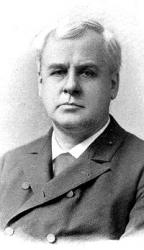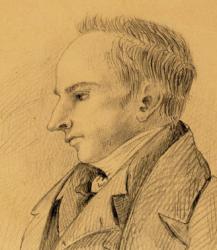Planning worship?
Check out our sister site, ZeteoSearch.org,
for 20+ additional resources related to your search.
- |
User Links
Person Results
‹ Return to hymnal


Export as CSV
Adoniram J. Gordon

1836 - 1895 Person Name: A. J. Gordon Hymnal Number: 121 Composer of "MY JESUS" in El Himnario Evangelico Adoniram J. Gordon (b. New Hampton, NH, 1836; d. Boston, MA, 1895) was educated at Brown University, Providence, Rhode Island, and Newton Theological Seminary, Newton, Massachusetts. After being ordained in 1863, he served the Baptist Church in Jamaica Plain, Massachusetts, and the Clarendon Street Baptist Church, Boston. A close friend of Dwight L. Moody, he promoted evangelism and edited The Service of Song for Baptist Churches (1871) as well as The Vestry Hymn and Tune Book (1872). Both Gordon College and Gordon-Conwell Theological Seminary are named after Gordon.
Bert Polman
==================
Gordon, Adoniram Judson, D.D., born at New Hampton, N.H., Apr. 19, 1836. Graduated at Brown University, 1860; entered the Baptist ministry; Pastor of Clarendon Street Baptist Church, Boston, 1869; and died in 1895. He published The Vestry Hymn and Tune Book, 1872; and was one of the editors of the Service of Song for Baptist Churches, 1871. His hymns in common use include:—
1. O blessed Paraclete. [Holy Spirit .] Given in Sursum Corda, 1898, as having been written in 1890.
2. O Spirit's anointing, for service appointing . [Foreign Missions.] This hymn was "written in the summer of 1886, at Northfield School for Bible Study, organised by Mr. Moody. More than one hundred college students connected with this school gave themselves to the work of foreign missions during their stay at Northfield. Four of their number were chosen to visit the colleges in different parts of the country, and endeavour to awaken a deeper interest in missions during the succeeding academic year. At their request Dr. Gordon” wrote this hymn. Baptist Hymns and Hymn Writers.
3. Where art thou, soul! I hear God say. [Divine Chiding.] Published in social meeting edition of The Service of Song, 1881.
--John Julian, Dictionary of Hymnology, New Supplement (1907)
Adoniram J. Gordon
Edward Husband
1843 - 1908 Person Name: E. Husband Hymnal Number: 219 Composer of "ST. HILDA" in El Himnario Evangelico Husband, Edward was educated at St. Aidan's College, Birkenhead. Taking Holy Orders in 1866, he was successively Curate of Atherstone and Folkestone; and in 1878 Vicar of St. Michael and All Angels, Folkestone. In 1874 Mr. Husband published The Mission Hymnal, in which appeared his hymns as follows:—
1. Alas! poor world, I loved thee long. Rest in Jesus.
2. And dost Thou ask me, dearest Lord. Christ's Invitation, " Follow Me."
3. I must have Jesus only. Jesus only desired
4. Sweet Blood, dear ransom of our souls. The Blood of Jesus.
These hymns are very simple, earnest, and impassioned: and bear a great resemblance to Facer's compositions.
--John Julian, Dictionary of Hymnology (1907)
Edward Husband
Mateo Cosidó
Person Name: M. Cosido Hymnal Number: 98 Author of "Levántate, Iglesia, sacude el sopor" in El Himnario Evangelico
Mateo Cosidó
M. N. Hutchinson
1835 - 1935 Person Name: M. N. H. Hymnal Number: 126 Translator of "Hay una fuente sin igual" in El Himnario Evangelico Merill N. Hutchinson.
As of 1871, Hutchinson was pastor of a Presbyterian church in Dunellen, New Jersey. In 1873, he resigned his pastorate and moved to Mexico City. His works include:
Himnario de las Iglesias Evangelica
Translations--
Amoroso Salvador
Con Cánticos, Señor
Hay una Fuente sin Igual
Obediente a Tu Mandato
© The Cyber Hymnal™ (www.hymntime.com/tch)
M. N. Hutchinson
Chrétien Urhan

1790 - 1845 Person Name: C. D'Urban Hymnal Number: 286 Composer of "RUTHERFORD" in El Himnario Evangelico Chrétien Urhan (Baptised as Christian Urhan; 16 February 1790, Montjoie - 2 November 1845, Belleville) was a French violinist, organist, composer and player of the viola and the viola d'amore.
His father first introduced him to the violin. He was first mentioned in 1804 by Joséphine de Beauharnais that he had replaced a violinist for a performance of Haydn's The Creation, at the young age of 14. From there he was sent to work in Paris, where he took instruction from Jean-François Lesueur, master of the chapel of the Tuileries. He also learned from prominent teachers such as François-Antoine Habeneck, Rodolphe Kreutzer and Pierre Rode. He was invited to join the imperial chapel as a violinist in 1810.
In this period the young Urhan shared lodgings with his friends the harpist Franz Anton Stockhausen (father of Julius Stockhausen) and the painter Carl Begas the elder (who was studying with Antoine Jean Gros, 1813-15). In 1815, through a Quartermaster in the Prussian army of occupation, Urhan and Stockhausen (who corresponded with Beethoven) obtained a score of Beethoven's Eroica Symphony and set it before Habeneck, with the result that the work was introduced to Paris. The two were among Amis de Beethoven, or Beethoven-Bruder in Paris, together with Wilhelm Mangold and others. In the early 1820s the violinist Sina, a member of the string quartet led by Schuppanzigh for Andreas Razumovsky, with Urhan gave new encouragement to Habeneck to continue with the master's works. Until Stockhausen's marriage to the singer Margarethe Schmuck, a member of their circle, in 1825, he lived with Urhan, who remained a lifelong friend.
In 1816, Urhan was appointed solo viola at the Opéra de Paris, and became solo violinist in 1825. Strongly Catholic, he was also appointed the organist at the Church of Saint-Vincent-de-Paul in Paris in 1827, a position that he held until his death. In this position he met the young Franz Liszt, with whom he played chamber music, and also the Beethoven Kreutzer Sonata in a mass. A number of composers wrote prominent parts for Urhan. Meyerbeer composed for him solo viola and solo viola d'amore parts in his opera Les Huguenots, and Rudolph Kreutzer, the solo viola d'amore part in his opera Le Paradis de Mahomet. In 1834, Berlioz wrote his Harold en Italie for orchestra with viola obbligato at the request of Niccolò Paganini, who refused to play the work. Berlioz offered the solo viola part to Urhan and the premiere was given on 23 November 1834 at the Paris Conservatory.
According to Ernest Legouvé, he was both entirely religious and entirely devoted to music. He lived like a medieval ascetic, abstaining from almost everything except his daily visit to the Café des Anglais. His love for theatre music created a severe inner conflict, which he overcame by asking the permission of the Archbishop to play in the orchestra of the Opéra (of which he was Leader), being told it was a matter for his own conscience. He accepted this by always being seated with his back to the stage, so that he never saw the singers or dancers for whom he played, even when providing solo accompaniment for a dancer.
Legouvé thought there were several greater violin virtuousi in Paris than Urhan, but that he outshone them through his profound knowledge of the masters and respect for their music, and through the indefinable quality of style which he brought to them. He often differed with Habeneck, when the conductor wanted to make cuts, and actually published and signed an article against Habeneck when he withdrew some double-basses from Beethoven's Choral Symphony. He did not merely guard the reputation of the old masters, but he was also a fierce advocate and defender of the new, and of those of the future. He was the first to introduce a song of Schubert's into France ('L'Adieu'). For Legouvé, to see him play was like watching Fra Angelico painting in his cell, a medieval mystic at work.
The Stockhausens visited Urhan in his fifth-floor Paris apartment in 1839, and found him living in great simplicity in two rooms, with a piano and five stools in his bedroom, where they sat and were made very welcome. In 1843 Urhan encouraged their son Julius while he was in Paris. In November 1845 Julius wrote to inform his parents of Urhan's death. He had been living in pitiable conditions in Belleville, and began to refuse his food: thoughts of suicide made him resolve to starve himself to death. He suffered agonies of pain and descended into a frenzy, giving terrible grief to his friends, none of whom could talk him out of it. All interventions failed, and Urhan, whom the Stockhausen and Legentil families considered their dear friend, and who had formerly taken communion every Sunday, lost his faith in God and his desire for life. Thus he died, quietly at last with friends at his bedside, on 2 November 1845.
--en.wikipedia.org/wiki/ (excerpts)
Chrétien Urhan
James Langran
1835 - 1909 Person Name: J. Langran Hymnal Number: 74 Composer of "LANGRAN" in El Himnario Evangelico James Langran (b. St. Pancras, London, England, November 10, 1835; d. Tottenham, London, England, June 8, 1909) studied organ as a youth but did not receive his Bachelor of Music degree from Oxford until he was forty-nine years old. He had several organist positions–the longest was at St. Paul's Church, Tottenham, England, from 1870 to 1909. He also taught music at St. Katherine's Training College for Schoolmistresses (1878-1909). Music editor of theNew Mitre Hymnal (1875), Langran composed around fifty hymn tunes and contributed several of them to early editions of Hymns Ancient and Modern.
Bert Polman
James Langran
William G. Tomer
1833 - 1896 Person Name: W. G. Tomer Hymnal Number: 254 Composer of "GOD BE WITH YOU" in El Himnario Evangelico Born: October 5, 1833, New Jersey.
Died: September 26, 1896, New Jersey.
Buried: Union Cemetery, Finesville, New Jersey.
Tomer studied singing and sang in the choir in Finesville, New Jersey, and began teaching school at age 17. He served in the Union army during the American civil war, then worked as a clerk in Washington, DC, served as music director for Grace Methodist Episcopal Church, and taught school in New Carpentersville and Greenwich, New Jersey. He was living in Greenwich as of 1880.
--www.cyberhymnal.org/
William G. Tomer
H. W. Greatorex
1813 - 1858 Hymnal Number: 335 Composer of "GLORIA PATRI" in El Himnario Evangelico Henry Wellington Greatorex United Kingdom 1813-1858. Born at Burton upon Trent, England, he received a thorough musical education from his father, Thomas Greatorex, who was for many years organist of Westminster Abbey, and conductor of the London concerts of ancient music. Henry became a composer, author, compiler, editor, and arranger of music. He emigrated to the U.S. In 1839. In 1849 he married artist Eliza Pratt, and they had four children: Elizabeth, Kathleen, Thomas, and Francis Henry. Prior to settling in New York City as a music teacher and organist at Calvary Church, he played at churches in Hartford, CT, including Center Church and St Johns Episcopal Church in West Hartford, CT. He frequently sang in oratorios and concerts. For some years he was also organist and conductor of the choir at St. Paul's Chapel. In 1853 he was an organist at St. Philip's Episcopal Church in Charleston, SC. He did much to advance the standard of sacred music in the U.S. In days when country singing school teachers imposed more rudimentary melodies on hymn books. He published a collection of “Psalm & hymn tunes, chants, anthems & sentences” (Boston 1851). He died of yellow fever in Charleston, SC.
John Perry
H. W. Greatorex
Pedro Grado
1862 - 1923 Person Name: P. Grado Hymnal Number: 319 Author of "Nada hay que me pueda apartar" in El Himnario Evangelico Pedro Grado Valdés studied law, but then wanted to become a pastor. He had a heart for helping the poor.
Dianne Shapiro from Celebremos su Gloria (Colombia/Illinois: Libros Alianza/Celebration), 1992
Pedro Grado


 My Starred Hymns
My Starred Hymns


